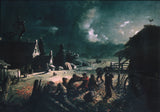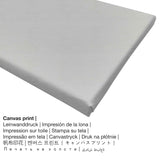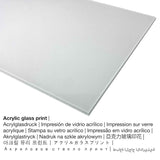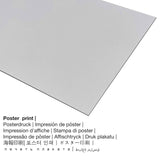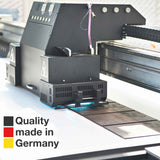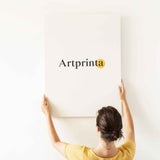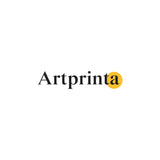David Gilmour Blythe, 1863 - Ọka Husking - mbipụta nka mara mma
Ụtụ gụnyere. Mbupu gbakọrọ na ndenye ọpụpụ.
Ozi ndabere ngwaahịa nka
Corn Husking is an artwork by David Gilmour Blythe in 1863. The more than 150 year-old original creation had the dimensions: 24 x 33 1/2 in (61 x 85,1 cm). Mmanụ na kwaaji was applied by the painter as the medium of the artpiece. Today, this work of art is included in the digital art collection of Museumlọ ihe ngosi nka nke Obodo. This public domain piece of art is being provided with courtesy of Ụlọ ihe ngosi nka nke Metropolitan, New York, Catharine Lorillard Wolfe Collection, Wolfe Fund, 1957. : Catharine Lorillard Wolfe Collection, Wolfe Fund, 1957. Furthermore, alignment is landscape and has an aspect ratio of 1.4: 1, nke pụtara na ogologo bụ 40% ogologo karịa obosara.
Nkọwa ndị ọzọ sitere na The Metropolitan Museum of Art (© Nwebiisinka - The Metropolitan Museum of Art - www.metmuseum.org)
Blythe, who lived in Pittsburgh, Pennsylvania, painted satires, mainly of urban ills, but in "Corn Husking," he portrayed their rural counterpart. The work depicts a sudden outbreak of violence on an eerie, moonlit night among a group of boys engaged in the taxing and tedious task of husking recently harvested corn. The farm is dilapidated and the farming implements are carelessly strewn around the property, conveying the harsh realities of the setting. Blythe pointedly made poverty and discord the crux of a theme that is usually associated with abundance and harmony.
Nkọwa ahaziri nke ọrụ nka
| Aha nke ihe nka: | "Corn Husking" |
| Nhazi nka nka: | sere |
| Okwu nche anwụ: | nkà nke oge a |
| oge: | 19th narị afọ |
| Emepụtara na: | 1863 |
| Afọ nka: | karịa afọ 150 |
| Ihe osise izizi: | mmanụ na kwaaji |
| Nha nke ihe nka izizi: | 24 x 33 1/2 na (61 x 85,1 cm) |
| Ụlọ ihe ngosi nka: | Museumlọ ihe ngosi nka nke Obodo |
| Ebe ngosi nka: | New York City, New York, Njikota Obodo Amerika |
| Ụlọ ihe ngosi nka webụsaịtị: | www.metmuseum.org |
| License: | ngalaba ọha |
| Site n'aka: | Ụlọ ihe ngosi nka nke Metropolitan, New York, Catharine Lorillard Wolfe Collection, Wolfe Fund, 1957 |
| Ebe E Si Nweta: | Catharine Lorillard Wolfe mkpokọta, Wolfe Fund, 1957 |
Ozi omenka
| aha: | David Gilmour Blythe |
| Aha nka ndị ọzọ: | Blythe David Gilmour, Blythe, David Gilmour Blythe, d.g. blythe |
| okike onye nka: | nwoke |
| Obodo onye nka: | American |
| Ọrụ onye na-ese ihe: | onye na-ese ihe |
| Mba onye si: | United States |
| nhazi ọkwa: | omenkà nke oge a |
| Ndụ: | 50 afọ |
| Afọ ọmụmụ: | 1815 |
| Obodo amụrụ: | East Liverpool, Columbiana County, Ohio, Njikota Obodo Amerika |
| Afọ nwụrụ: | 1865 |
| Nwuru na (ebe): | Pittsburgh, Allegheny County, Pennsylvania, Njikota Obodo Amerika |
Akụrụngwa ị nwere ike isi na ya nweta
In the dropdown lists right next to the product you can select a material and a size of your choice. You can choose your your favorite size and material among the following options:
- Mbipụta nke aluminom: An Aluminium Dibond print is a print material with an impressive depth - for a modern impression and a non-reflective surface structure. For your Print On Aluminum Dibond, we print the selected artpiece onto the aluminium composite surface. Colors are bright and luminous, the fine details of the print are clear and crisp.
- Akwụkwọ mmado ebipụtara (akwa akwa akwa): The poster print is a printed cotton canvas with a granular surface finish. It is ideally suited for placing the art copy in a personal frame. Please keep in mind, that depending on the absolute size of the canvas poster print we add a white margin 2-6cm around the painting, which facilitates the framing.
- Mbipụta kwaaji: The canvas print, which should not be confused with a painting on a canvas, is an image printed on a UV direct printing machine. How do I hang a canvas on the wall? Canvas prints are relatively low in weight. This means, it is easy to hang up your Canvas print without the use of any wall-mounts. A canvas print is suited for any type of wall.
- Bipụta na enyo acrylic: An acrylic glass print, which is sometimes described as a UV print on plexiglass, makes an original into stunning décor and is a distinct alternative option to dibond and canvas fine art replicas. The work of art is custom-made with modern UV printing machines. This has the image effect of impressive and vivid color tones. The major advantage of a plexiglass print is that contrasts and also granular details become more recognizeable because of the delicate tonal gradation of the picture.
Nkọwa ngwaahịa
| Ụdị edemede: | nka nka |
| Usoro mmeputakwa: | dijitalụ mmeputakwa |
| Production usoro: | Mbipụta UV / dijitalụ |
| Mmalite ngwaahịa: | German mere |
| Stockdị ngwaahịa: | a na-achọ |
| Ihe eji eme atụmatụ: | mgbidi gallery, mgbidi mgbidi |
| Ntuziaka onyonyo: | nhazi odida obodo |
| Ụdị anya: | 1.4: 1 |
| Nkọwa: | ogologo bụ 40% ogologo karịa obosara |
| Ihe mmeputakwa dị: | Mbipụta iko acrylic (nke nwere ezigbo mkpuchi iko), mbipụta akwa akwa, mbipụta akwụkwọ mmado (akwụkwọ kwaaji), mbipụta ọla (aluminium dibbond) |
| Nhọrọ nha nha mbipụta kanvas (akwa akwa na etiti ihe ndọtị): | 70x50cm - 28x20", 140x100cm - 55x39" |
| Mbipụta iko acrylic (nwere ezigbo mkpuchi iko) dị iche iche: | 70x50cm - 28x20", 140x100cm - 55x39" |
| Nhọrọ nke mbipụta akwụkwọ mmado (akwụkwọ kwaaji): | 70x50cm - 28x20" |
| Nhọrọ Dibond (ihe alumnium) nhọrọ: | 70x50cm - 28x20", 140x100cm - 55x39" |
| Nhazi mmeputa nka nka: | na-enweghị etiti |
Nkwupụta iwu: We try whatever we can to depict our art products as accurate as possible and to showcase them visually in our shop. Please bear in mind that the pigments of the print materials and the imprint may differ marginally from the representation on your monitor. Depending on the screen settings and the nature of the surface, colors can unfortunately not be printed as exactly as the digital version shown here. Because our art reproductions are processed and printed by hand, there might as well be slight deviations in the motif's size and exact position.
© nwebiisinka site na - Artprinta.com

